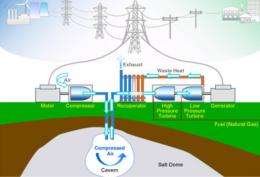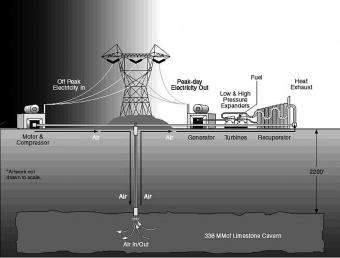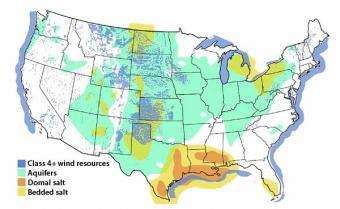March 17, 2010 report
Compressed Air Energy Storage: Renewable Energy

(PhysOrg.com) -- Wind-power turbines have played an important step in renewable energy but now the future of wind power may be underground. By using compressed-air energy storage plants, air is pumped into large underground formations where it can be used later to deliver a large amount of energy that it received.
Electricity is cheapest in the middle of the night and by running air compressors, air can be pumped into a cavern or vessel at 750 psi. In the daytime, when the price of electricity is expensive, the compressed air is preheated with the heat generated and stored during compression and then used to help power a turbine.

CAES (compressed air energy storage) is relatively low efficiency and prices out to about $1000 per kilowatt of storage as compared to about $3000 per kilowatt for lead acid battery storage. These estimates are according to EPRI (Electric Power Research Institute).
There are currently a few CAES projects underway that are slated for government funding:
• New York State Electric and Gas is currently working on a CAES project that involves pumping compressed air into a salt cavern in upstate New York
• Pacific Gas and Electric is looking at a 300MW CAES project in Kern County
EPRI has determined that up to 80 percent of the US has geology suitable for CAES. EPRI has established that a single 300MW CAES plant would require about 22 million cubic feet of storage space; this storage space would yield eight hours of electricity.

From the above map it can be seen that hundreds of 300 megawatt CAES plants can be constructed across the US. This is relatively inexpensive and can turn intermittent renewable energy sources like wind into more reliable power distribution.
More information: www.espcinc.com/
© 2010 PhysOrg.com

















